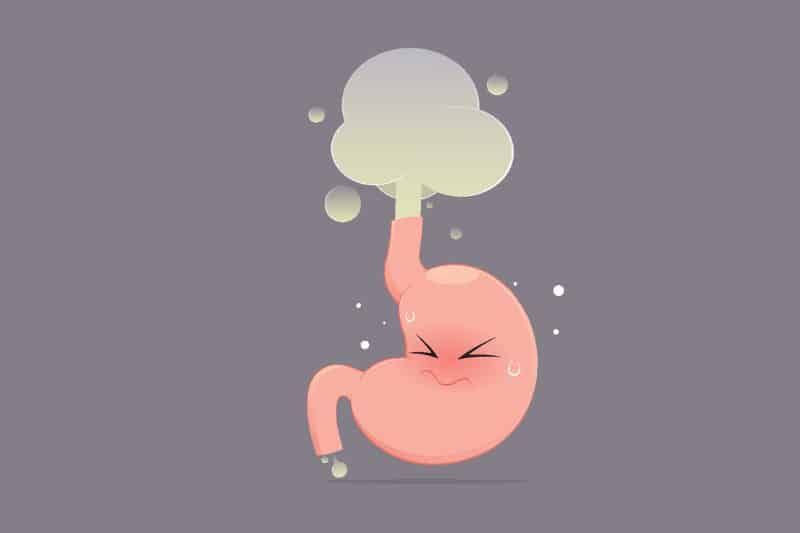Why Do I Fart So Much? Understanding Excessive Flatulence

Farting (quiet honestly we cannot believewe are actually discussing this) or flatulence is a completely natural bodily process. In reality, the average person breaks wind anywhere from 13 to 21 times per day. But if you're farting more often than is really convenient for you, you might wonder what's causing it and whether it's a symptom of a larger problem. Gas can certainly beembarrassing and uncomfortable, but in almost all cases, it's not cause for serious medical concern. Many factors, from what you eat to the state of your digestive health, can contribute to increased gas production. Getting to the bottom of what's behind these “gassers”can help you keep it under control, or even prevent it.
1. What Causes Frequent Farting?
Diet is one of the most frequent causes of extreme flatulence. There are some foods that are known to create gas when they're broken down in the digestive system. Beans, lentils, broccoli, cabbage, onions and carbonated beverages all are notoriously guilty. These are food high in fiber or complex carbohydrates that the body cannot break down effectively. When the undigested fragments make it to the colon, bacteria in your gut ferment the material, generating gases such as hydrogen, carbon dioxide and methane, thereby boosting flatulence.
Lactose intolerance is another dietary factor. Too many people have too little of that enzyme, known as lactase, to digest dairy products. When lactose digests poorly, it ferments in the gut, leading to the formation of extra gas. If you experience bloating and gas after consuming milk, cheese or ice cream, then it might be lactose intolerance.
Drinking too much air, known as aerophagia, can also lead to persistent farting. This happens to you if you routinely eat too fast, chew gum frequently, apply carbonated drinks, or smoke. You can even swallow air while you're talking or eating, and that eventually needs to come up.
Digestive problems also lead to too much of passing gas. What we call IBS, SIBO, celiac, and gastroenteritis are all conditions in which normal digestion is interfered with, resulting in a higher amount of gas production.
2. How to Stop Farting So Much?
There are some dietary changes that you can make if your excessive flatulence is due to what you're eating. Writing down what you eat and then how much gas you develop is another way to help you determine which foods cause you gas. One way your digestive system might acclimate is if you slowly cut back on high-fiber or gas-producing foods and reintroduce them in smaller amounts. Lactose-free dairy or lactase pills punctured before consumption will help reduce the discomfort for those with lactose intolerance.
Chewing slowly and paying attention to what you eat can result in your swallowing less air, reducing gas. Eliminating carbonated beverages and gum-chewing can also be helpful. On top of all that, exercise stimulates digestion and moves gas through the intestines faster to reduce bloating and flatulence.
Consuming probiotics, which are in yogurt, kefir and supplements, may also help keep your gut microbiome in better balance between good and bad bacteria. This may also aid in digestion and eliminate excessive gas. Peppermint tea or even ginger decrease gas as well.
3. When Should You See a Doctor?
Some gas is normal, but if you have chronic or very smelly gas, even if it's with a constellation of other gut symptoms, an investigation with a healthcare provider might be in order. Chronic bloating, not to mention sharp, abdominal pain, blood in your stool or changes to your stool, could be a sign of a more serious digestive disorder. Medical causes of bloating conditions like Irritable Bowel Syndrome (IBS), Inflammatory Bowel Disease (IBD) or food intolerance will need a professional diagnosis and medical treatment.
In short, everyone gets gassy, it's a normal byproduct of digestion, and even if you're too mortified to discuss gas, it's good to know what the different culprits are so you can eventually find relief or at least be slightly more at ease. But if the symptom is persistent or gets worse, a visit to the doctor will likely verify that there's nothing else to worry about.
 Disclaimer:
Disclaimer:
The content provided on our blog site traverses numerous categories, offering readers valuable and practical information. Readers can use the editorial team’s research and data to gain more insights into their topics of interest. However, they are requested not to treat the articles as conclusive. The website team cannot be held responsible for differences in data or inaccuracies found across other platforms. Please also note that the site might also miss out on various schemes and offers available that the readers may find more beneficial than the ones we cover.
Related Websites
-
 Automotive
AutomotiveWhy Should We Choose Hertz Car Rentals?
In thisage of rapid globalization, nothing beatsconvenience,dependability and high-quality services in the transport sector. Whether you need to rent aset of wheels for business travel, family vacations or just a temporary replacement of your vehicle, partnering with the right car rental provider can make a world of difference. With all the options these days, Hertz Car Rental is one ofthe top choices formany customers around the world. Here aresome reasons why Hertz is a great option for your rental requirements.1.Global Reach and AvailabilityHertz is undoubtedly theoldest and most recognized name in the car rentals industry andhas operated in a whopping 150 countries and thousands of places. Hertz is likely to have a rental location by you if you’re flying into a big international airport or need a vehicle in a smaller city. And although it doesn’t happen as often, this extensive network means you can easily secure a Hertz rental wherever your travels take you, making ita reliable option for domestic and international trips alike.2.Wide Range of Vehicle OptionsHertzprovides a great spread of options to suit every need and desire. Solo traveler who wants to roam in a compact car, a family who needs space with an SUV, ora guy just looking to roll in a luxury car for a big date,Hertz has you covered. Also, for the environmentally minded customer Hertz offers the hybrid and electric option. This variety ensures that there's alwaysthe perfect car for you, whether you want fuel economy, comfort or style.3.Exceptional Customer ServiceHertz's reputation was built oncustomer service. Whether youneed as much help as deciding the right vehicle for you or questions about rental policies. Its team is trained for everything. Hertz's 24/7 customer support means you'll have someone to turn to when you need it most, whether it's the middle of the day or the middle of the night. And Hertz's strong focus on customer satisfaction differentiates it from a host of competitors.4.Technological SupportsHertz has harnessed new technologies to enhance therental experience. It also allows customer to easily book, modify orcancel anybookings on its customer friendly website or mobile application. Hertz also features its Gold Plus Rewards program that offers benefits,such as expedited check-in and check-out, customized offers and points for free rentals.Hertz is extending contactless rental with curbside pickup and digital contracts, in response to current health consciousness at the moment, especially widespread high hygiene awareness and COVID-19 pandemic.5.NoHidden Fees and Easy to Change PolicyHertz transparentpricing structure rental plans range from daily or weekly plans to long-term plans, so customers can select the option that fits theirbudget and schedule. Hertz has flexible cancellation policies,so you can change plans without steep penalties. This transparencyand flexibility establish Hertz as a reliable option for travelers.6.Firm Indicators of SafetyandCleanlinessHertzis following strict hygiene protocols to keep its customers safe.The vehicles are deep cleaned and disinfectedbetween rentals, paying particular attention to high touch-point surfaces.In an effort to reduceface time, Hertz has contactless rentals offering peace of mind for travelers.7.Corporate and Long-TermRental SolutionsHertz caters not only to leisure travelers but also to businesses and people who need long-term rentals. Through their corporate programs, they provide customized solutions for companies, such as discounted rates, line-itemized billing, and fleet management solutions. Hertz also offers long-term rental options for those who need a vehicle for an extended period; these rentals are more flexible and cost-effective than leasing or ownership.With its global reach, various car types and technological supports, Hertz is at the top of car rental industry and brings exceptional rental experience. Hertz gives you the reliability, convenience, and peace of mind that you require for a stress-free trip, whether you are traveling for work or play.So, next time you rent a car, rent withHertz and see for yourself. -
 Travel
TravelThe Most Scenic Road Trips in the United States
The US is a country with everything from rugged coastlines and towering mountains to vast deserts and lush forests. For the travelloversin all of us, there's no way to experience the natural beauty of this great country than jumping in your car and taking to the open highway.Here are some of the most scenic drives that will provide memorable views and excursions.1.California State Route 1 (Pacific Coast Highway)Perhaps this is the world’s most famous road trip. The Pacific Coast Highway runs along the California coast. Starting in Dana Point and finishing in Leggett, it’s a gorgeous ride featuring the Pacific Ocean, dramatic cliffs and lovely seaside towns like Monterey and Santa Barbara.The scenic views include Bixby Creek Bridge in Big Sur, Point Lobos State Natural Reserve and the Malibu beaches. With sunsets over the ocean or whales spotted from the roadside, this drive is a sensory feast.2.Blue Ridge Parkway (From Virginia to North Carolina)This road is regarded as “the favorite drive in America”. It winds its way through Appalachian Mountains, connecting the Great Smoky Mountains National Park in Carolina with the Shenandoah National Park in Virginia. This 469-mile trip is the quintessential rolling hills, bright autumn leaf color and inviting mountain vistas. Along the way, you’ll traverse hiking trails and scenic overlooks, including the truly breathtaking LinnCove Viaduct, where you can admire the area views. The parkway’s slower speed invites visitors to detour and take in nature’s beauty.3.Route 66 (from Illinois to California)Though not necessarily the most picturesque route, Route 66 is an iconic slice of American history and culture. Passing through small towns, deserts and the Cadillac Ranch in Texas and the Grand Canyon in Arizona, this historic highway stretches between Chicago and Santa Monica. Although a lot of original roadways have been replaced by the modern freeways, these roads still offer you the chance to drive across the center of America. Along the neon lights, roadside views and stops, you can start a nostalgic travel.4.Going-to-the-Sun Road (Glacier National Park,Mont.)This road, which is 50 miles long, is considered to be an industry miracle, and it is one of the most beautiful roads in Rocky Mountains. It winds across the Glacier National park, you can see Logan Pass and the Weeping Wall. But the pity is that the road is only open seasonally, generally between late June through October (depending on weather), so plan accordingly to see this breathtaking drive.5.Peninsular Corridor Highway (Florida Keys)The 113 miles of road known as the Overseas Highway, which links mainland Florida to popular vacation destination Key West, while always zips over the turquoise waters of the Atlantic Ocean and Gulf of Mexico. That route correct 42 bridges, including the famous Seven Mile Bridge, and offers stunning views of both ocean — seawater never freezes — and the Keys’ tropical foliage. On the way, you can pull over to snorkel or fish, or to feast on fresh seafood at waterside restaurants. It concludes at Key West, a lively island town famous for its sunsets and relaxed vibe.6.Utah’s Scenic Byway 12 (Bryce Canyon to Capitol Reef)Utah’s Scenic Byway 12 is a drive that desert landscape lovers will not want to miss. This 124-mile drive runs through some of the state’s most breathtaking national parks and monuments, including Bryce Canyon, Grand Staircase-Escalante and Capitol Reef. The drive includes red rock formations, soaring cliffs and wide-angle views that feel almost otherworldly. The Hogback, a narrow ridge with steep drop-offs on each side, also delivers thrilling views of the surrounding canyons.All over the United States, scenic drives offer different lenses through which to appreciate this country’s changing landscapes. Whether you’re cruising the scenic Pacific Coast Highway, driving mountain passes or visiting desert wonders, these road trips promise unforgettable memories and spectacular sights. So get your bags, get in the car, and make the journey just as memorable as where you end up. -
 Home & Garden
Home & GardenThings You Should Consider Before Buying Furniture
Purchasing furniture is a big investment in both the financial and living-space-impacting considerations. Whether you’re moving into a new home or simply refreshing your current one, there are a handful of things to keep in mind before buying. By taking the time to consider these details, you can make well-informed choices and find pieces for your home that are right for you and make your home sparkle.1.BudgetConsider your budget first. Prices for furniture can start low and go high, so establish beforehand how much you’re comfortable spending before you shop. Remember that it can be an attractive option to go for the cheapest one, but the quality is often more expensive. Think about the furniture’s staying power — investing money in the right thing that you like, and that will last a while, will usually be cheaper than buying something that’s — for lack of a better word — temporary, and needs replacing in a few years.2.Space and SizeMeasure your space carefully before you fall in love with a particular piece of furniture. Think not just about the size of the room, but the layout, and how the new piece can work with your other furniture. A big couch might look great on the showroom floor, but if it dwarfs your living room, it won’t be functional. Conversely, having a small dining table could be limiting if you regularly have many guests over. Just make sure to factor in walking space, and that the furniture won’t block doors, windows or other places you need access to.3.FunctionalityConsider how the furniture will be used. If you’re purchasing a sofa, will it mostly be for lounging, or do you require something more formal for entertaining? If you are buying a bed, think about whether you need storage space underneath it. For dining tables, consider whether you want extendable options for larger groups. Furniture that do not work with your lifestyle or daily needs are useless.4.Style and AestheticsYour furniture needs to represent who you are and mesh well with the beauty of all your rooms. Take note of the color scheme, materials, and design of the pieces you’re interested in. Do they complement your current decor, or will they pop in a way that you love? Just keep in mind that while trends can be seductive, classic styles often endure a bit longer. If in doubt, neutral colors and timeless designs tend to be a safe choice.5.Material and DurabilityHow important is the material of furniture for both theaesthetics and durability? Everyone has their own pros and cons, wood, metal, glass, or upholstery. Balancing expenses although solid wood furniture is sturdy and lasts for years, it might feel like an investment that is a little more to maintain compared to less expensive options like multi-purpose wood or press wood furniture.Upholstered furniture is cozy and chic but can be prone to staining and wear. Think about your lifestyle — if you have kids or pets, you may want to select materials that are easy to clean and resistant to damage.6.ComfortComfort is key, particularly for furniture you will be using regularly, like sofas, chairs and beds. Use your eyes, but not just your eyes — try out the furniture if you can. Sit on the sofa, lie down on the bed and see that the furniture is comfortable to suit your requirements. What makes someone comfortable may not be what makes another person comfortable. Search at your speed to find the items you truly want to use.To sum up, purchase of household furniture is a decision to be planned thoroughly with care.Ultimately, by keeping in mind your budget, the space in your home, functionality, style, material, comfort, maintenance, sustainability, and delivery options, you can make selections that will add to and serve your home and your needs for years to come. So take your time, do your research, and ask questions if needed before you buy. Because the right furniture can change how you live in your home, and whether it is a pleasant place to spend time.
Featured Articles
-
 Travel
TravelMust-Try Rides and Attractions at Disneyland: The Ultimate Guide
-
 Home & Garden
Home & GardenTips to Remove Urine Stains from Your Mattress
-
 Home & Garden
Home & GardenCabinet Kitchen: The Heart of Modern Home Design
-
 Automotive
AutomotiveHow the Cadillac LYRIQ Stands Out in the Luxury Electric SUV Market
-
 Health & Wellness
Health & WellnessEtiology of Hives
-
 Health & Wellness
Health & WellnessHeavy Sweating: Heat or an Issue with Health?
-
 Travel
TravelMust-See Attractions in Las Vegas
-
 Finance
FinanceTypes of Loans: A Comprehensive Guide








